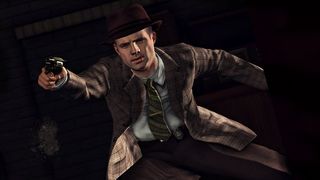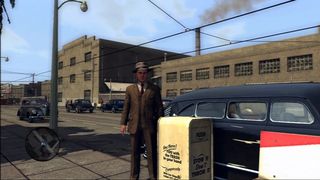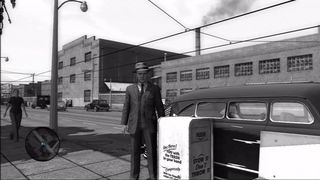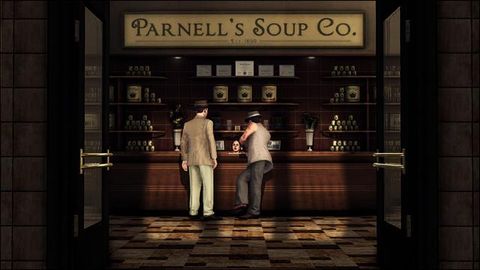Why you can trust GamesRadar+
While investigations and interrogations make up the bulk of the game, they’re far from all you’ll do. For whatever reason, almost nobody in LA ever wants to surrender to the police, whether they’re actually guilty or not – and so, most of your accusations will either send the perps running, or make them decide a fistfight with cops is just a fantastic idea.

Above: Stupid stupid stupid
If they run – which seems to happen at least once in almost every case – you’ll have to take off after them while your partner stays behind. As you follow the perp through the nearby neighborhood (and/or across nearby roofs), your goal is to get close enough to sprint in and tackle him to the ground. Provided, that is, that the chase isn’t meant to end up at a certain spot on the map (like a waiting getaway car, say), in which case your perp will frequently surge away with sudden bursts of superhuman speed whenever you get close.
Even at their worst, though, chases are still more fun than Noire’s handful of “follow that car, but maintain a consistent distance” tailing missions. They may be thematically appropriate, given that you’re playing as a cop, but that doesn’t make them much fun.

Fighting is considerably more enjoyable than either chasing or tailing, even if it seems strange at first that everyone assumes stiff boxing stances when things get violent (just tell yourself they all learned to box in the Marines). It’s simple, but being able to block or dodge, unleash flurries of punches, grapple with opponents and pull off simple finishers means there’s just enough variety to make it satisfying.
Of course, most criminals are smart enough to know that putting up their dukes is a dumb idea, and so more often than not you’ll have to contend with armed resistance. This is, incidentally, about the only time the game lets Cole (automatically) draw his gun. Combat in L.A. Noire works like a slightly simplified version of GTA/Red Dead Redemption’s gunfights, with Cole able to easily flatten himself against sticky-cover points and either blind-fire around the corner, or pop out for an aimed shot.

Aimed shots work a lot like Red Dead’s, in that you’ll automatically draw down on the nearest enemy (which you can turn off if you’d rather free-aim). This doesn’t always work so well when they’re behind cover (the reticule tends to land on their covered body mass, rather than their exposed heads), but it does make rapidly putting down groups of enemies a breeze, particularly if you’ve picked up a shotgun, a Thompson or a BAR. As fun as the shootouts are, however, there’s one problem: for some reason, the only real feedback when you’re being shot is that blood appears on Cole’s clothes and the screen starts going gray. It’s usually easy to spot before it’s too late, but a little force-feedback warning would have been better.
Interestingly, you don’t always have to kill armed suspects; if they’re running from you, you might have the option of firing off a warning shot by holding the reticule over their backs until a little meter fills up. These opportunities are rare, hard to pull off and don’t seem to make any difference to the overall plot, but they’re a nice alternative for more pacifistic players.

Story-related shootouts tend to be short and relatively few, but they’re not the only action you’ll find. As you drive through town, you’ll periodically get dispatch calls about street-crime incidents, which you’re free to break off and pursue. These range from muggings and suicide attempts to bank robberies and hostage situations, and they tend to involve a lot of driving and/or shooting, making them feel like a consolation prize for those upset that Noire isn’t more like GTA.
There are 40 of the incidents in all, and each desk has its own set to respond to. The best part, however, is that you never have to worry about missing an opportunity. Incidents come up again later if you ignore them, and if you’d rather put them off indefinitely, they can also be pursued during the free-roaming modes unlocked after completing each desk.

That brings us to driving. Noire’s cars are mostly period-appropriate land-yachts, although it’s worth pointing out that few of them feel as sluggish as they look. Your average police cruiser does pretty well taking sharp turns at top speed (although you might take out a streetlamp or two in the process), and if it isn’t enough, you can “commandeer” nearly any other vehicle you see on the road. (Buses are sadly off-limits.) Driving is also one of the few parts of the game that let you act like a complete psychopath, and it’s kind of hard to resist the temptation of driving on the sidewalk when it’s lined with so many smashable benches and parking meters (never mind that the damage you cause is counted against you on your end-of-case report card).

Above: Ha ha, whoops
With so many different kinds of gameplay (and a few unique minigames thrown in for good measure), Noire is anything but small or short – all told, it took us around 20 hours to finish the story, and that was ignoring most of the side stuff. For those who want to take the time to complete every street-crime case, find every car and unearth every landmark, newspaper and collectible film reel in the game, it’ll probably take closer to 30 hours. And even then, it’s worth replaying the story at least once. Certain events take on new significance when viewed with knowledge of Noire’s endgame twists, and it’s interesting to see how differently the cases can turn out – and what new chunks of plot they might yield – if you do a more thorough job of finding clues and getting questions right.
Also, a second playthrough is a great opportunity to try out one of Noire’s most interesting semi-secrets: a black-and-white mode hidden in the options menu. It’s a little weird, maybe, but it’s cool to see Noire looking like an actual 1947 film.


While it’s marred by occasional choppy visuals and a late-in-the-story twist that seems like a sudden betrayal of Cole’s identity (and could therefore have used more buildup), L.A. Noire is nonetheless an incredible achievement. Its hyper-realistic faces, while strange at first, are easy to get used to, and the world that it’s created – from its licensed radio shows to its re-creations of long-demolished old-Hollywood landmarks – is a blast to explore. More importantly, this isn’t just well-written, pretty and genuinely mature – it’s immensely fun, and after the years of hype and waiting, it does not disappoint.
That just leaves one question…
More info
| Genre | Action |
| Description | L.A. Noire is a staggering technological achievement, offering up a fantastically detailed open world, a hugely engrossing story, varied gameplay and some of the best acting performances ever to appear in a game. More impressively, all of its parts work together beautifully, creating an immensely fun adventure that’s worth replaying at least once. |
| Platform | "Xbox 360","PS3","PC" |
| US censor rating | "Mature","Mature","Mature" |
| UK censor rating | "18+","18+","18+" |
| Release date | 1 January 1970 (US), 1 January 1970 (UK) |

Steam changes its refund policy so that pre-order early access playtime now counts towards the 2 hour rule

Quentin Tarantino's scrapped 'final' movie would have reportedly brought back some of his iconic characters in a "movie within a movie"

Samsung’s brand-new 2024 OLED TV has already dropped in price, and it’s begging to meet your PS5

